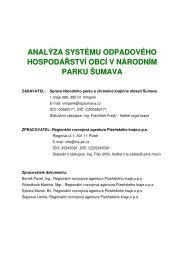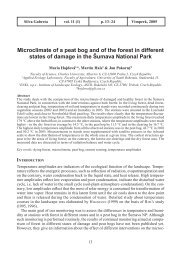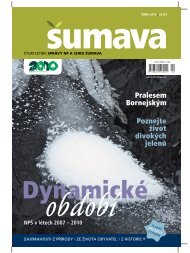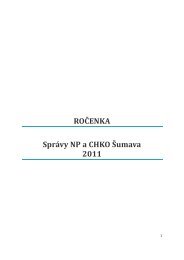Algae, Cyanobacteria and Chytridiales of Černé Lake in the ...
Algae, Cyanobacteria and Chytridiales of Černé Lake in the ...
Algae, Cyanobacteria and Chytridiales of Černé Lake in the ...
Create successful ePaper yourself
Turn your PDF publications into a flip-book with our unique Google optimized e-Paper software.
<strong>in</strong> <strong>the</strong> Bohemian Forest have not been published yet, but species richness can be estimated<br />
as follows: Čertovo <strong>Lake</strong> – 50, Prášilské <strong>Lake</strong> – 40, Plešné <strong>Lake</strong> – 50, <strong>and</strong> Laka <strong>Lake</strong> – 50<br />
(LUKAVSKÝ, unpubl. data).<br />
Taxonomy remarks<br />
<strong>Černé</strong> <strong>Lake</strong> is a locus classicus for algal taxonomy. FOTT (1937, 1938) described three species<br />
new to <strong>the</strong> science from here (Bitrichia ollula, Katod<strong>in</strong>ium bohemicum, <strong>and</strong> K. planum);<br />
ROSA (1941) found 11 new species for Bohemia <strong>and</strong> LUKAVSKÝ (2006) found C. pascheri, sp.n.<br />
<strong>and</strong> Stomatocyst 35 <strong>and</strong> Stomatocyst 73 sp.n. for Bohemia, as well <strong>in</strong> <strong>the</strong> lake.<br />
Stomatocysts are a prospective tool for long-term monitor<strong>in</strong>g, toge<strong>the</strong>r with Bacillariophyceae<br />
<strong>and</strong> scales <strong>of</strong> chrysomonads, because <strong>the</strong>y are very resistant to decay <strong>and</strong> could be<br />
determ<strong>in</strong>ed from <strong>the</strong> sediment cores. FACHER & SCHMIDT (1996) determ<strong>in</strong>ed 126 morphotypes<br />
<strong>of</strong> stomatocysts <strong>in</strong> surface sediments <strong>of</strong> 50 lakes <strong>of</strong> Central Europe, with a strong<br />
correlation to pH (r2 = 0.78). <strong>Černé</strong> <strong>Lake</strong> was sampled, but its cores have not been evaluated,<br />
yet.<br />
Stomatocyst 35 Duff & Smol 1989 (Fig. 2: 14, Fig. 7: 2,3, Fig. 8: 1,2) is, accord<strong>in</strong>g to <strong>the</strong><br />
unpublished op<strong>in</strong>ion <strong>of</strong> H. KLING, <strong>the</strong> cyst <strong>of</strong> Mallomonas doignonii (DUFF et al. 1995). The<br />
cyst was also found on <strong>the</strong> surface <strong>of</strong> mud <strong>in</strong> <strong>the</strong> littoral <strong>and</strong> <strong>in</strong> <strong>the</strong> hypolimnion <strong>of</strong> Grosser<br />
Arbersee <strong>and</strong> Kle<strong>in</strong>er Arbersee <strong>in</strong> <strong>the</strong> Bavarian Forest. Until now, it has been mentioned as<br />
well from Canada: Northwest Territories, <strong>Lake</strong> Ontario, <strong>and</strong> British Columbia; USA: Connecticut,<br />
New York, <strong>and</strong> Oregon; <strong>and</strong> Europe: Denmark. It was found <strong>in</strong> acidic or neutral<br />
cold waters. This alga is new for <strong>the</strong> Czech Republic, as a recent organism, but it was found<br />
by FACHER & SMITH (1996) <strong>in</strong> Plešné <strong>Lake</strong>, <strong>in</strong> a core from <strong>the</strong> depth <strong>of</strong> 14.5–15 cm; it has no<br />
clear ecological preference accord<strong>in</strong>g to <strong>the</strong> latter authors.<br />
Stomatocyst 73 Duff & Smol 1991 (Fig. 7: 1). The biological aff<strong>in</strong>ity <strong>of</strong> this organism is<br />
unknown (DUFF & SMALL 1995). It was described from Upper Wallface Pond, Adirondack<br />
Park, NY, U.S.A. from a core <strong>in</strong> a depth <strong>of</strong> 10–10.5 cm, <strong>and</strong> also from <strong>the</strong> Yukon Territory,<br />
Canada. It is produced by an organism tolerant to pH



![Zima 2008 [4MB] - Národní park Šumava](https://img.yumpu.com/21236024/1/184x260/zima-2008-4mb-narodni-park-sumava.jpg?quality=85)






